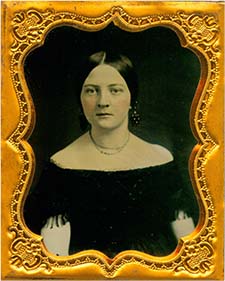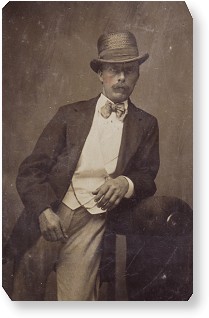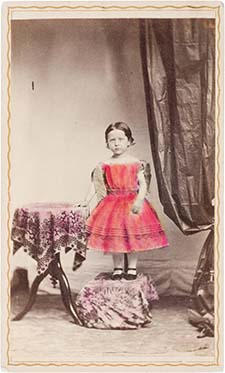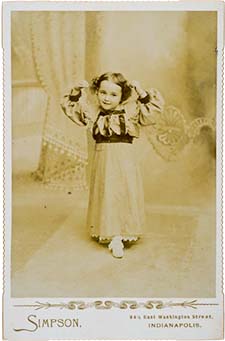| |
A Historical Overview |
|
A brief history of 19th century photographs is presented for background. A list of notable books is included for those wishing to learn more about early photographs.
|
|
|
19th Century Photographic Formats
PhotoTree looks at the history of 19th century photographs from the view of five distinct photographic technologies and their eras.
-
Daguerreotypes
-
Ambrotypes
-
Tintypes
-
Cartes de Visite
-
Cabinet Cards
While they overlapped in time, these technologies form the basis of a system to date the pictures of the 1800s with a high degree of accuracy. |
|
Daguerreotype Announcement
January 7, 1839 Paris announcement in The Literary Gazette
"We have much pleasure in announcing an important discovery made by M. Daguerre, the celebrated painter of the Diorama. This discovery seems like a prodigy. It disconcerts all the theories of science in light and optics and, if born out, promises to make a revolution in the arts of design." |
|
|
|
|
Daguerreotype: 1839 - History Begins
1839 is recognized as the dawn of photographic history, even though many people were working on various techniques for nearly 30 years prior.
Louis Jacques Mande Daguerre, a commercial artist and theater producer worked for 10 years improving upon a method pioneered by Niespece.
Mr. Daguerre was a skilled promoter also. Realizing that maintaining financial control of the process would be nearly impossible once it was published, he persuaded the French government to grant him a pension for life in recognition of this breakthrough he was giving the world.
The daguerreotype became an instant commercial success around the world. There were over 70 photography studios in New York City in 1850 producing daguerreotypes.
The Daguerreotype was the predominant means of photography until the late 1850s. By this time, less expensive, easier to produce Ambrotypes became popular. Virtually all serious Daguerreotype photography ceased by the mid-1860s. |
|
Silver Mirror
This 1841 Daguerreotype is the oldest in the Phototree collection.

|
|
|
|
|
Ambrotype: 1854 - Image on Glass
Various alternatives to the expensive and difficult Daguerreotype process were tried in the 1840s and 50s. In 1854 James Cutting, an American, patented a new process that produced a very attractive image on glass. A high quality piece of glass was treated with a light sensitive collodion, and then it was exposed in a camera. The developed image was a glass negative. The back of the glass was then coated with a black varnish, or sometimes a black mat was placed behind it, creating a 'positive' look.
During the early years of the ambrotype, the image side was turned face down, and a second piece of glass was glued to the back.
In the late 1850s, various colored glasses were used instead of clear glass, with ruby the favorite color. This produced a richer image and eliminated the need to blacken the back of the image glass.
The ambrotype's life span was historically short, seldom seen after the mid-1860s, yet it yielded a vast collection of beautiful images. |
|
Glass Beauty
Many beautiful ambrotype images were created. Still fragile, they were always placed in cases.

|
|
|
|
|
Tintype: 1856 - Images for the Masses
Patented in 1856 by Ohio chemistry professor Hamilton Smith, the tintype method was not particularly new, but an evolution from earlier experiments and existing commercial processes. Creating a tintype involved essentially the same processes as those used for ambrotypes, but the image surface, was iron instead of glass. Many collectors and traders often mistake one type of photograph for the other when the photographs are in cases.
The tintype, actually misnamed, is an iron plate that has been coated with a black lacquer. This lacquer (sometimes referred to as japan, from the substance's country of origin) provided a smooth tonal surface on which to develop the image and it prevented the iron from rusting. The tintype was more commonly known in its time as a ferrotype (ferrous being the name of iron from your chemistry class), and melainotype, a variation of the melano prefix meaning dark or black.
The tintype enjoyed the longest success of any 19th century photographic process in history. Even though its popularity was overcome by new paper images in the 1860s, it was still produced until the early 1900s. In the latter years tintypes were mostly produced as souvenirs at carnivals and side shows. |
|
Durable, Inexpensive
This ca. 1870 tintype is created on iron that has been coated with a black enamel, and later brown or chocolate enamel as this picture shows.

|
|
|
|
|
Carte de Visite : 1859 - aka CDV
The term carte de visite translates to visitor card, though was seldom seen in everyday use. The Photograph Manual: A Practical Treatise published in 1862 refered to the format as carte de visite, but acknowledged that the common name was card portrait. This term was soon replaced by card picture, card photograph or simply card. The acronym CDV, seems to be a 20th century invention as no reference to it has been seen in 19th century books, advertisements or other works.
Following the evolutionary trend of earlier processes, the CDV was easier and more economical to produce than the tintype since the image was developed on paper. Thin high quality paper was coated with albumen, made from egg whites, and then sensitized with a silver solution. Albumen eventually yellows, which gave images the familiar sepia or brown-tone hue. While the photographic paper and card stock it was mounted on was not as durable as the tintype iron plate, the CDV was able to bring a higher quality image to the consumer. Plus the images looked more elegant and were easier to handle |
|
First Paper Images
The CDV brought about the flourishing of inexpensive photographs for everyone.

|
|
|
|
|
Cabinet Cards: 1866 - Modern Elegance
The cabinet card was a larger, more refined version of the carte de visite. By the early 1880s it had nearly replaced all CDVs, and was the dominant portrait format until the end of the century.
This new format employed the same steps for making CDVs: still exhibiting the sepia look, but with an image area more than double the CDV. It was introduced in the late 1860s in England, but did not gain much attention in the U.S. until the mid-1870s. While it was a bigger image than the CDV, it did not offer much of a quality difference until the mid-1880s. That is when the effect of new photographic papers and camera improvements really became apparent.
|
|
Modern People and Looks
The 1890s allowed people to exhibit their personalities and have fun with photographs.

|
|
|
|
|